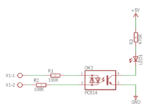venkates2218
Full Member level 6

The input will vary from 150VAC to 280VAC.If the supply is available means the LED have to glow....
I'm new to this circuit.So I don't known in-depth.I tried with hardware,if the voltage is low means the LED not glowing,so I changed the resistance value to low(56K). If the resistor value is low means when high voltage across the IC become faulty.
If the resistance value is high means,at low voltage the LED not glowing...
How to solve this issue and to make the LED glow in specified voltage range.





